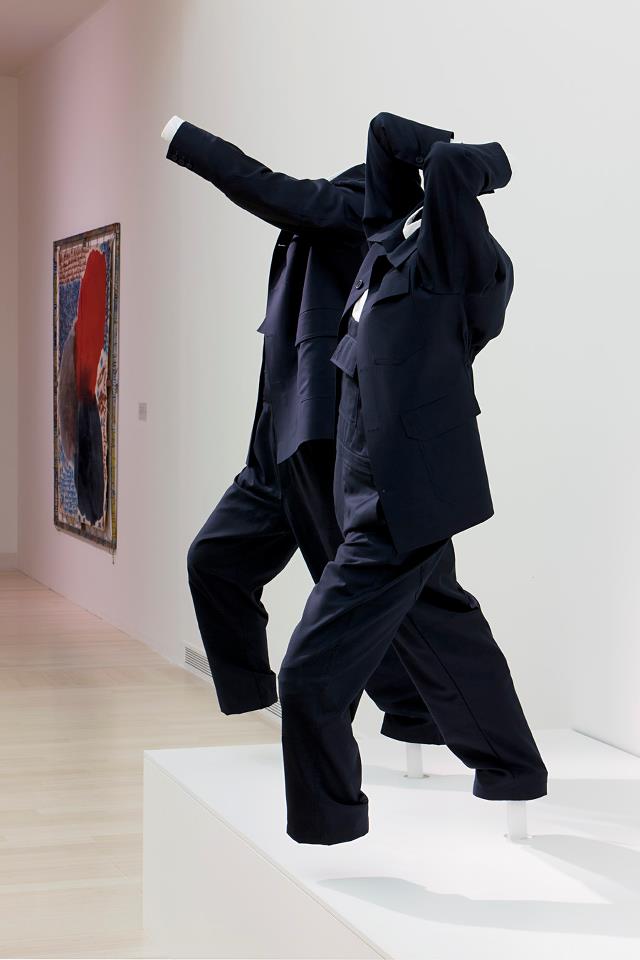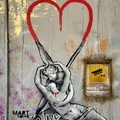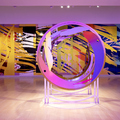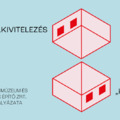The new permanent exhibition of Ludwig Museum opened in December that presents the collection from a new, exciting approach: it focuses on the dialogue between the former “east” and “west”. The curator of the exhibition, Krisztina Szipőcs demonstrates the most important artists and pieces of art from the post-Second World War period through nearly 80 pieces centering the exhibition on a theme that is also an integral part of the history of the museum itself.
The Other Half of the SkyHow long have you been working in Ludwig Museum and what is your job exactly?
I have been working here for a long time, from January, 1994. I was the second art historian who had specifically worked for the museum. In 1989, the year of Ludwig Museum’s establishement it was still operating within the confines of the Hungarian National Gallery. Néray Katalin, the former director of Műcsarnok was asked at the end of 1992 to be the director of the new establishment. From 1993, as far as the financials allowed she organized temporary exhibitions and we have started to develop the museum’s infrastructure. I have started here as a junior art historian, I have served my apprenticeship here, and assisted the director with several exhibitions and in the meantime I have also maintained the collection. 1996 marked the first major turn in the life of the museum when it formed into a contemporary art museum, what resulted in the broadening the collection and in an increase in the number of the museum staff. That is when I became the head of the exhibition and collection department. The museum has moved to its present building in 2005. Between 2006 and 2008 I have worked as a commissioned deputy director. During the operation of the new director, Barnabás Bencsik I have took over the leadership of the collections department that is also an exciting and interesting task.
You are the curator of the exhibition entitled „The Other Half Of The Sky- a selection of the collection of Ludwig Museum”. How is an exhibition like this organized? How much work is put into the organization from the idea to the opening?
Organizing an exhibition from the collection is kind of a special case. One of the most important task is to show something new, to defer from the former exhibitions from the collection that the visitors are bored of. However because I am also teaching art history and often interacting with outsiders, people who are out of the art circles I felt that those previous exceedingly interesting exhibitions we have organized from the collection do not provide a stable base for art history and do not present the exuberance of the collection to those tourists for example who are in Budapest for the first time. We thought that these significant art pieces should be on view continuously so that they can serve as references. Only we possess original Picasso paintings in the country, but I can also mention Warhol, Lichtenstein, Rauschenberg or Wolf Vostell, who were all great artists of the post-World War period. We are proud that these pieces are a part of our collection, and on the other hand it is also important for the visitors that these works can be continuously available.
The Other Half Of The Sky is an exhibition of the collection, however only a fragment of it is exhibited. What was the concept in mind when choosing the exhibited pieces?
As I was thinking about the exhibition and tried to make a selection of the works, I have come to the conclusion that the central theme could be the relation between the art historic mainstream and the artists of east-Europe. Moreover this was always a central question in the history of the museum. Here, in the east due to historic causes we have always struggled with an inferiority complex through the 20th century as our art is delayed, worse, does not catch up with the world, etc. This can be true from one perspective, but on the other hand as it is based on a totally different experience, it has a different social, historical background it shows peculiar characteristics. Actually I wanted to show these parallel stories in these rooms with a focus on the points of connection.
 István Csákány: Ghost Keeping
István Csákány: Ghost Keeping
The first room was dedicated to the Ludwig couple. Can it be affiliated with the theme of the exhibition?
Yes, absolutely. Firstly I wanted to dedicate one room the history of the museum, on the other hand the figure of Peter Ludwig himself illustrates beautifully the dual story we are talking about. He was the first western art collector who turned to the art of the countries behind the iron curtain with interest, he collected them, established foundations and tried to exhibit his collection in east Europe. As a first step he tried to exhibit in East- Berlin at the end of the ’70s: he deposited art pieces that he took back later, a part of what has ended up in Budapest and Vienna. Practically he tried to expand more and more to the east. It is an interesting fact that only the Hungarian cultural government was willing to exhibit and take in the collection –although shortly before the regime change- and sign the contract that lead to the founding the museum.
Ghost Keeping, the installation of István Csákány also due to its size has a central place in the exhibition. The piece was lent to the museum for the exhibition. How does it relate to the theme of the exhibition?
This piece is sort of the odd one out, however it is not. The exhibition displays works from the ’60s to the regime change, only two works are included that were made after 1989: one is a portrait of Ludwig, and the other one is a work from Daniel Spoerri, the likes of which he makes from the ’60s- the technique and the idea remained the same. The installation of Csákány was an unexpected proposal, I had to think about the means of fitting it into the concept of the exhibition. On the other hand the Documenta of Kassel on what this piece was first exhibited in 2012 had an exceedingly important role in the dialogue between east and west, in the attempts of accession and in the shaping of an artistic field of reference. This substantial contemporary art event was an initiative after the World War in the Germany of the ’50s that aimed at rehabilitating those progressive artistic endeavors that the Nazis declared as degenerate art. Documenta is a significant exhibit organized every 5 years whose exhibitors are assuredly in the so called mainstream. Although many have tried only a very few Hungarian artists could have the possibility to be included in the selection of Documenta during its long history. We have quite peculiar stories: for example at the beginning of the ’70s with the leadership of László Lakner a group of neo avant-garde Hungarian artists tried to get included in Documenta. On the basis of Lakner’s idea they have formed a soccer team and have wrote to Harald Szeeman that they would have liked to play a match with an international team in the Fridericianum. Later Lakner finally got to exhibit his hyperrealist paintings on account of his own merits at the second half of the ‘70s, and also at the beginning of the ‘90s János Sugár could get a place among the exhibitors, however up to this point a Hungarian artist did not have such an outstanding opportunity like this before.
Therefore virtually he was included in the exhibition because he exhibited at Documenta?
From the region we are constantly striving for being part of the big artistic canon- this has resulted in a positive outcome. A relatively young artist, nearly from nothing as a result of a serious preparation -in what Ludwig Museum and within it the ACAX had a great role- could get so far as having a huge room just for himself in Kassel.
The monumental installation is very appealing for the visitors: it urges them to observe it closely. What is the message of the piece?
Csákány – as it can be read in several texts about him – would like to depict the peculiar Eastern European past, he tries to create the monument of the working class. For example the concrete sculpture entitled The worker of tomorrow, service uniform is of this kind, what was included in our collection: it is an empty shell, a case that surrounds “the worker”.
In case of Ghost keeping we see a complete factory, a sewing mill from what the characters, the workers are missing. In the same way the figures placed around are also only empty shells. The artist calls these figures ghosts: they represent the ghost of the working class. Csákány predominantly refers to the changing social relations: there is a left wing tradition that speaks about the working class, the peasants and the oppressive classes; however it is a 19th century idea. We have very different social classes in modern capitalism. The work of Csákány raises the following questions: how did the so called socialist society before 1989 transform after 20 years, what kind of capitalism has formed and can we call this system capitalism at all?
The sewing mill of a little village West of the Danube served as a model for the installation, where the ladies are sewing great suits for Western European orders- this might be one of the forms of modern day colonialism. Although a unified European system exists we see that the production is shifted to the East because the wages are lower there. To sum it up the work raises many interesting questions. The visitors are spellbound also by the performance: there has to be a great amount of sculptural craftsmanship to perfectly copy a sewing mill.
How do the visitors who go to the museum and expect to see traditional paintings and sculptures relate to such an installation? Another example can be the work of Endre Tót entitled Musketeer. Are not the visitors shocked by an empty white canvas facing a Picasso painting? Do you manage to get contemporary art closer to the visitors?
Various means exist for the interpretation of the works and the exhibition, for helping the visitors that the museum needs to use well: guided tours, museum education programs. It’s true that explanatory texts are missing from this exhibition for now, -that was a result of shortage of time-, however we plan to refill these continuously. On the other hand I increasingly feel that the younger generation do not expect the traditional painting-sculpture painting-sculpture exhibitions from the museum, they discover the novelties and find them interesting. Wow, an entirely empty picture!- what does he want with that? People look at a Picasso, okay, it is quite interesting, we know his style, but why does Endre Tóth exhibit an “empty” picture? These are much more interesting questions. I strived for placing a marginal note, a footnote or a video in every room of the exhibition that disrupts this so to say traditional system, makes it more interesting or even questions it.
Are specific museum educational programs connected to this exhibition?
Yes, we have several different programs about what you can read a lot on our website. The museum educators can treat the exhibitions quite creatively. They can approach them from a point so that they would relate to certain school lessons. This exhibition is primarily about politics and history; however they can affiliate the works even to a mathematics lesson.
Does the museum educator negotiate with you in these cases?
To tell you the truth, they know these art pieces and their treatment by heart; these are the main works from the collection, for what they have worked out all kinds of programs. And we are not only talking about children here, they are working with different age groups: elderly people and the so called average visitor alike. For example a guided tour belongs to this exhibition, where they deal with emotions conveyed by the works, as fighting against each other. For example the chess set of Yoko Ono: it raises the question what is the use of fighting against each other, or how can a conflict be resolved? This guided tour is lead by a psychologist.
In 1997 a New York gallery was equipped with white chess boards, where the artist herself participated in the games. Was there a possibility to try the chess board out at a guided tour session?
Unfortunately the paint is peeling off the chess set a little, thus we will not let the visitors use it, however that is the reason why duplicates were made that the museum educators can use in the sessions. For example a huge outdoor chess board was made for the children what they can play with- against each other, but more so with each other.







A bejegyzés trackback címe:
Kommentek:
A hozzászólások a vonatkozó jogszabályok értelmében felhasználói tartalomnak minősülnek, értük a szolgáltatás technikai üzemeltetője semmilyen felelősséget nem vállal, azokat nem ellenőrzi. Kifogás esetén forduljon a blog szerkesztőjéhez. Részletek a Felhasználási feltételekben és az adatvédelmi tájékoztatóban.